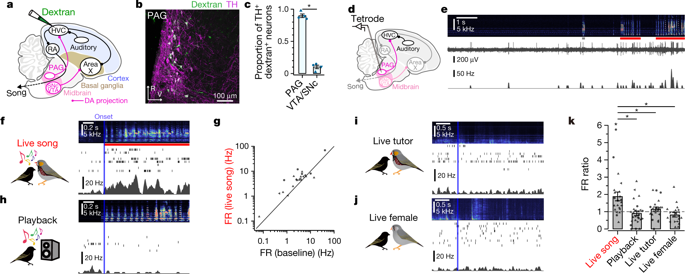Our official English website, www.x-mol.net, welcomes your
feedback! (Note: you will need to create a separate account there.)
A mesocortical dopamine circuit enables the cultural transmission of vocal behaviour
Nature ( IF 50.5 ) Pub Date : 2018-10-17 , DOI: 10.1038/s41586-018-0636-7 Masashi Tanaka 1, 2 , Fangmiao Sun 3, 4 , Yulong Li 3, 4, 5 , Richard Mooney 1
Nature ( IF 50.5 ) Pub Date : 2018-10-17 , DOI: 10.1038/s41586-018-0636-7 Masashi Tanaka 1, 2 , Fangmiao Sun 3, 4 , Yulong Li 3, 4, 5 , Richard Mooney 1
Affiliation

|
The cultural transmission of behaviour depends on the ability of the pupil to identify and emulate an appropriate tutor1–4. How the brain of the pupil detects a suitable tutor and encodes the behaviour of the tutor is largely unknown. Juvenile zebra finches readily copy the songs of the adult tutors that they interact with, but not the songs that they listen to passively through a speaker5,6, indicating that social cues generated by the tutor facilitate song imitation. Here we show that neurons in the midbrain periaqueductal grey of juvenile finches are selectively excited by a singing tutor and—by releasing dopamine in the cortical song nucleus HVC—help to encode the song representations of the tutor used for vocal copying. Blocking dopamine signalling in the HVC of the pupil during tutoring blocked copying, whereas pairing stimulation of periaqueductal grey terminals in the HVC with a song played through a speaker was sufficient to drive copying. Exposure to a singing tutor triggered the rapid emergence of responses to the tutor song in the HVC of the pupil and a rapid increase in the complexity of the song of the pupil, an early signature of song copying7,8. These findings reveal that a dopaminergic mesocortical circuit detects the presence of a tutor and helps to encode the performance of the tutor, facilitating the cultural transmission of vocal behaviour.A dopaminergic mesocortical circuit in juvenile zebra finches detects the presence of an adult zebra finch tutor and helps to encode the performance of the tutor, facilitating the cultural transmission of vocal behaviour.
中文翻译:

中皮层多巴胺回路使声音行为的文化传播成为可能
行为的文化传播取决于学生识别和模仿合适导师的能力1-4。学生的大脑如何发现合适的导师并编码导师的行为在很大程度上是未知的。幼年斑胸草雀很容易复制与其互动的成年导师的歌曲,但不会复制他们通过扬声器被动聆听的歌曲 5,6,这表明导师产生的社交线索有助于模仿歌曲。在这里,我们展示了幼雀中脑导水管周围灰质中的神经元被唱歌导师选择性地激发,并且通过在皮质歌曲核 HVC 中释放多巴胺来帮助编码用于声音复制的导师的歌曲表现。在辅导期间阻止学生 HVC 中的多巴胺信号传导阻止复制,而将 HVC 中的导水管周围灰色终端与通过扬声器播放的歌曲配对刺激足以驱动复制。接触歌唱导师会引发学生 HVC 中对导师歌曲的快速反应,并迅速增加学生歌曲的复杂性,这是歌曲抄袭的早期特征 7,8。这些发现表明,多巴胺能中皮层回路检测到导师的存在,并有助于对导师的表现进行编码,促进声音行为的文化传播。 斑胸草雀幼年的多巴胺能中皮层回路检测到成年斑胸草雀导师的存在和有助于对导师的表演进行编码,促进声音行为的文化传播。
更新日期:2018-10-17
中文翻译:

中皮层多巴胺回路使声音行为的文化传播成为可能
行为的文化传播取决于学生识别和模仿合适导师的能力1-4。学生的大脑如何发现合适的导师并编码导师的行为在很大程度上是未知的。幼年斑胸草雀很容易复制与其互动的成年导师的歌曲,但不会复制他们通过扬声器被动聆听的歌曲 5,6,这表明导师产生的社交线索有助于模仿歌曲。在这里,我们展示了幼雀中脑导水管周围灰质中的神经元被唱歌导师选择性地激发,并且通过在皮质歌曲核 HVC 中释放多巴胺来帮助编码用于声音复制的导师的歌曲表现。在辅导期间阻止学生 HVC 中的多巴胺信号传导阻止复制,而将 HVC 中的导水管周围灰色终端与通过扬声器播放的歌曲配对刺激足以驱动复制。接触歌唱导师会引发学生 HVC 中对导师歌曲的快速反应,并迅速增加学生歌曲的复杂性,这是歌曲抄袭的早期特征 7,8。这些发现表明,多巴胺能中皮层回路检测到导师的存在,并有助于对导师的表现进行编码,促进声音行为的文化传播。 斑胸草雀幼年的多巴胺能中皮层回路检测到成年斑胸草雀导师的存在和有助于对导师的表演进行编码,促进声音行为的文化传播。











































 京公网安备 11010802027423号
京公网安备 11010802027423号